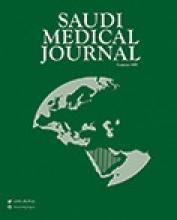Abstract
OBJECTIVE: The purpose of this study is to analyze the soft tissue cephalometric norms of the Saudi population and to evaluate whether significant cephalometric soft tissue differences exist between Saudi and Caucasian population.
METHODS: Lateral cephalometric radiographs of 40 selected Saudis with esthetically pleasing faces (20 males and 20 females). The study was carried out in the College of Dentistry, King Saud University, Riyadh, Kingdom of Saudi Arabia between 1999 - 2001. The age range between 20 and 30 years was analyzed using Burstone system of soft tissue analysis. The means, standard deviations and ranges of the measurements were compared between males and females, and both figures correlated with the results obtained for a Caucasian population.
RESULTS: Statistically, the facial convexity angle (glabella-subnasale-soft tissue pogonion) was found to be less convex for the Saudi group; the maxillary prognathism was more anterior, and the upper and lower lip positions were more anterior.
CONCLUSION: The results of the present study are significant, and showed that the normal Saudis have a slightly lesser obtuse nasolabial angle, and a more anteriorly positioned upper and lower lips. These results have a clinical implication in the diagnosis and treatment of adult Saudis with dentofacial deformities.
- Copyright: © Saudi Medical Journal
This is an open-access article distributed under the terms of the Creative Commons Attribution-Noncommercial-Share Alike 3.0 Unported, which permits unrestricted use, distribution, and reproduction in any medium, provided the original work is properly cited.






